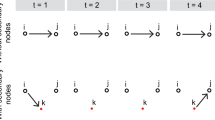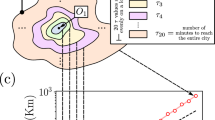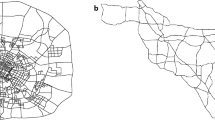Abstract
The idea behind our theorem1 is simple. It can be illustrated by using airline travel as an example. Consider a stream of people (blood) leaving London (heart) at a steady rate and fanning out to all parts of the world (body). The number of people leaving London each day and arriving elsewhere at their final destinations (metabolic rate) is denoted by B. Assuming that the people travel along a locally connected network and that the transit time for each local hop is the same (say, 1 day), the number of people in transit at any given time (blood volume) is proportional to B, but with a proportionality constant that is given by the mean number of hops from all the destination cities to London.
Similar content being viewed by others
Banavar et al. reply
This additional factor arises because if, for example, there are P people who arrive in, say, Paris (let us assume Paris is two hops from London — London-Brussels-Paris) each day, there are 2P passengers in transit at any given time whose final destination is Paris (P of them are en route from London to Brussels and the other P are travelling from Brussels to Paris). In a D-dimensional space, if B scales as LD, our theorem asserts that because the mean number of hops must itself scale at least as L, the total number of people in transit must scale at least as LD+1
Haff points out the difference between the scaling properties of water flow and sediment transport in rivers and that river sediments can be stored in flood plains. Although water flow at a given point is proportional to the area of the sub-basin draining into it, the sediment discharge is not, because the source of sediments is not uniform in space, unlike the rainfall in landscape-forming events5. Rather, sediment production is scattered in space and time, and not isochrone with the main transport mechanisms in the network. In fluvial systems, scaling networks are stationary structures derived from the evolutionary dynamics of the topography of landscapes6.
Painter's exercise of the parallelepiped, showing that the mean number of hops from the origin, <LX>, is proportional to L is in accord with our theorem. Painter assumes that the blood in the network is proportional to the number of links — or, by analogy, that the total number of people in transit is proportional to the number of operating flights — but this assumption is wrong because there are many more people crammed into flights originating from London than in those from cities distant from London. The number of flights is indeed proportional to the number of destinations and the metabolic rate B. The branching network in Painter's last paragraph is a Cayley tree which, for large enough sizes, cannot exist in any finite-dimensional space. The observation that in an N-site Cayley tree the average distance from the origin scales as lnN, which is what would be expected for a D-dimensional lattice in the infinite D limit, agrees with our theorem.
We do not believe that fractal-like networks effectively endow life with an additional fourth dimension3. Allometric scaling comes built in with any system in which the flow is directed and the circulation time is proportional to circulation length, irrespective of size1. The fact that nature, in spite of her extreme diversity, exhibits allometric scaling to the extent she does in plants, animals and river networks suggests that optimality associated with directedness is quite common.
References
Banavar, J. R., Maritan, A. & Rinaldo, A. Nature 399, 130– 132 (1999).
Schmidt-Nielsen, K. Scaling: Why is Animal Size so Important? (Cambridge Univ. Press, 1984).
West, G. B., Brown, J. H. & Enquist, B. J. Science 284, 1677– 1679 (1999).
Ritter, D. F., Kochel, C. R. & Miller, J. R. Process Geomorphology 3rd edn (WCB/McGraw-Hill, Boston, 1995).
Rodriguez-Iturbe, I. & Rinaldo, A. Fractal River Basins: Chance and Self-Organization (Cambridge Univ. Press, New York, 1997).
Banavar, J. R. et al. Phys. Rev. Lett. 78, 4522– 4525 (1997).
Author information
Authors and Affiliations
Corresponding author
Rights and permissions
About this article
Cite this article
Banavar, J., Maritan, A. & Rinaldo, A. reply: Rivers, blood and transportation networks. Nature 408, 160 (2000). https://doi.org/10.1038/35041635
Issue Date:
DOI: https://doi.org/10.1038/35041635
This article is cited by
-
Determinants of inter-specific variation in basal metabolic rate
Journal of Comparative Physiology B (2013)
-
Supply-demand balance in outward-directed networks and Kleiber's law
Theoretical Biology and Medical Modelling (2005)
-
Biological scaling and physics
Journal of Biosciences (2002)
Comments
By submitting a comment you agree to abide by our Terms and Community Guidelines. If you find something abusive or that does not comply with our terms or guidelines please flag it as inappropriate.



